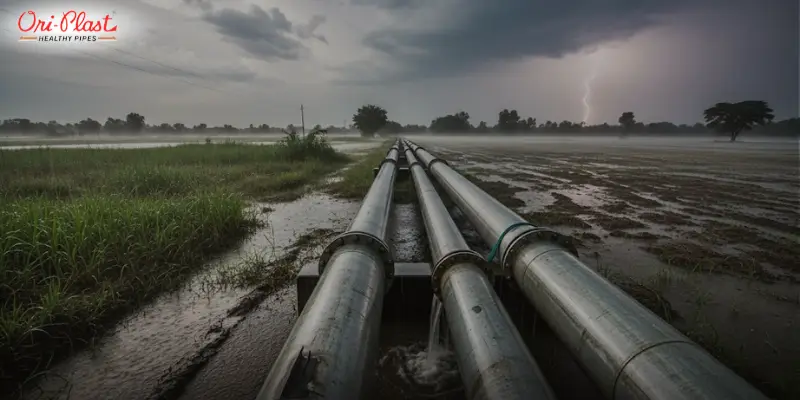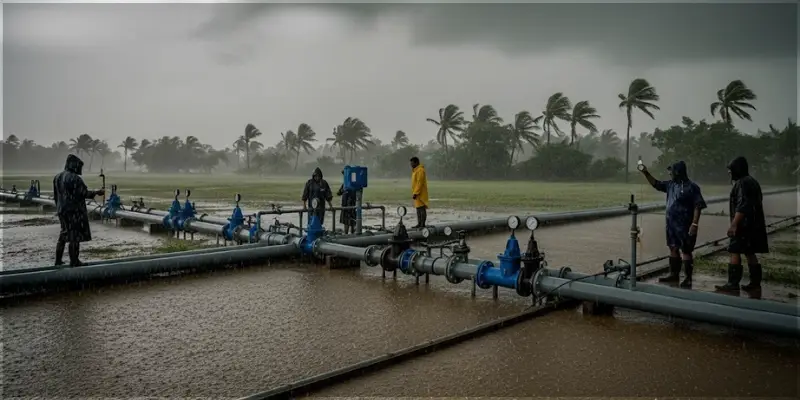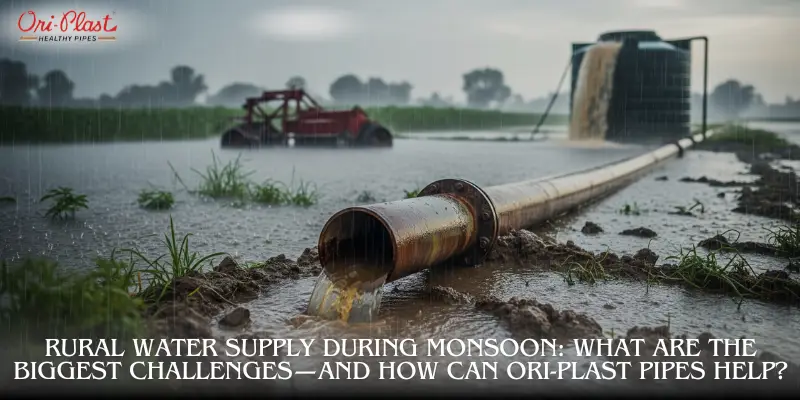Why Monsoon is a Real Test for Rural Water Infrastructure
 Rural areas in India often rely on long-distance pipelines to deliver water from sources such as rivers, borewells, or reservoirs. During the monsoon:
Rural areas in India often rely on long-distance pipelines to deliver water from sources such as rivers, borewells, or reservoirs. During the monsoon: - Soil becomes waterlogged, causing instability around buried pipelines.
- Floodwaters displace or break poorly installed pipes.
- Jointed pipes may start leaking or even burst due to water pressure.
- Contaminated floodwater can enter through cracks or weak points.
What Makes a Pipe Ideal for Rural Water Supply?
When it comes to selecting the best pipe for water supply, especially in rural projects affected by seasonal weather, consider the following essential criteria:- Durability: Pipes must withstand soil erosion, high groundwater levels, and corrosion.
- Flexibility: To survive shifting soil or flood conditions.
- Jointless System: Fewer joints mean less leakage.
- Lightweight for Easy Transport: Especially in remote regions.
- Safe for Drinking Water: Pipes must meet potable water standards.
- Eco-Friendly Production: ISO 14001:2015 certified HDPE pipes in India indicate environmentally responsible manufacturing.
Traditional vs. Modern Pipe Materials: Which One Lasts Through Monsoon?
Let’s compare the common materials used for rural water supply systems:| Pipe Material | Monsoon Performance | Limitations |
| GI (Galvanized Iron) | Rigid and corrosion-prone | Leaks, rust, and heavy to transport |
| Cement/Concrete | Brittle, can crack under shifting soil | High maintenance, absorbs water |
| PVC | Lightweight, affordable | Less flexible under stress |
| HDPE (Ori-Plast) | Excellent: flexible, corrosion-resistant | Best suited for rural & monsoon zones |
The Ori-Plast Edge: Built for Monsoon, Built for Rural
 Ori-Plast has built a strong reputation by offering piping systems that are not only engineered for performance but are also suited for the environmental challenges of India. Their range includes HDPE and uPVC pipes, both of which are ideal for monsoon-hit rural regions.
Ori-Plast has built a strong reputation by offering piping systems that are not only engineered for performance but are also suited for the environmental challenges of India. Their range includes HDPE and uPVC pipes, both of which are ideal for monsoon-hit rural regions. 1. HDPE Pipes for Rural Projects
- Made from high-density polyethylene.
- Highly resistant to soil movement and flood pressure.
- Seamless fusion joints mean leak-proof systems.
- Lightweight yet strong for easy handling and transport.
- Ideal for irrigation, drinking water, and drainage systems.
- Manufactured to international standards like ISO 14001:2015 certified HDPE pipes in India, showcasing Ori-Plast’s commitment to the environment.
2. uPVC Pipes for Domestic Rural Use
- Best suited for borewells, home plumbing, and overhead tanks.
- Non-toxic and lead-free for drinking water safety.
- Corrosion-proof and highly durable.
- Easy to install with minimum maintenance required.
- Cost-effective choice for smaller applications in villages.
Real-World Applications: Ori-Plast in Rural India
Ori-Plast pipes are being used in major government projects across India. Their participation in schemes like Jal Jeevan Mission, AMRUT, and PMKSY has helped provide consistent and clean water to rural households. Example: In flood-prone districts of Assam and Bihar, Ori-Plast’s HDPE pipes were installed under rural drinking water schemes. Even during peak monsoon, the pipelines faced no leaks or disruptions. Communities experienced better water quality, and maintenance needs dropped significantly. This practical proof makes Ori-Plast the go-to solution and clearly the best pipe for water supply under harsh conditions.Long-Term Benefits of Choosing the Right Pipe
Choosing Ori-Plast means making a future-focused investment. Here are some long-term gains:- Minimal Repairs: Reduced chance of failure even during monsoon.
- Consistent Water Access: Joint-free and durable systems ensure uninterrupted supply.
- Health Safety: Pipes are non-toxic, corrosion-free, and suitable for drinking water.
- Cost-Effective Over Time: Reduced labor, fewer breakdowns, and long-lasting performance.
- Meets Regulatory Compliance: Aligns with India’s rural development programs and environmental standards.
- Infrastructure Longevity: HDPE and uPVC pipes from Ori-Plast can last 15–20 years or more with minimal upkeep.
Final Thoughts: Weather the Storm with Ori-Plast
Every year, the monsoon puts India's rural water infrastructure to the test. Failures are common where poor-quality pipes are used. But there is a better way. By choosing Ori-Plast’s HDPE and uPVC pipes—engineered for strength, flexibility, and longevity—you can ensure that water keeps flowing, no matter how heavy the rain falls. Trusted by government bodies and infrastructure developers alike, Ori-Plast provides reliable and eco-conscious solutions. Their systems are not only strong but also safe for health and the environment. Choosing the best pipe for water supply is not just about surviving one monsoon—it’s about building a water system that works year after year. Looking to future-proof your rural water project? Explore Ori-Plast’s full range of HDPE and uPVC piping solutions designed for monsoon durability and rural performance. Choose Ori-Plast. Build strong, safe, and smart.Frequently Asked Questions (FAQ)
What is the best pipe for water supply in rural areas?
The best pipe for water supply in rural areas is HDPE (High-Density Polyethylene) due to its flexibility, durability, and resistance to leaks and corrosion. Ori-Plast HDPE pipes are especially suitable for rural and monsoon-prone regions.Why are HDPE pipes better than traditional GI or cement pipes during the monsoon?
HDPE pipes are lightweight, flexible, and fusion-welded, making them leak-proof and ideal for handling ground shifts and floods. GI and cement pipes are heavy, prone to rust or cracking, and harder to maintain.Are Ori-Plast pipes certified for environmental safety?
Yes, Ori-Plast’s HDPE pipes are ISO 14001:2015 certified, meaning they are produced under strict environmental management standards and are eco-friendly.Can Ori-Plast pipes be used for drinking water supply?
Absolutely. Ori-Plast’s HDPE and uPVC pipes are non-toxic and safe for potable water systems, making them ideal for rural households and communities.How long do Ori-Plast HDPE pipes last in rural installations?
Ori-Plast HDPE pipes can last 15 to 20 years or more with minimal maintenance, even in flood-prone and remote regions.Do HDPE pipes require special equipment to install?
HDPE pipes can be easily installed using standard fusion welding machines. Their lightweight nature also makes them easy to transport and handle in rural settings.What government projects use Ori-Plast pipes?
Ori-Plast products are widely used in central and state-led schemes like Jal Jeevan Mission, AMRUT, and PMKSY for rural water supply and irrigation.Are Ori-Plast pipes resistant to UV and chemical exposure?
Yes. Ori-Plast HDPE pipes are UV-stabilized and have high resistance to chemicals, making them suitable for exposed and chemically active areas.How do Ori-Plast uPVC pipes compare to HDPE for rural applications?
uPVC pipes are ideal for household-level applications like borewells and tanks, while HDPE pipes are better for large-scale water distribution in rural infrastructure.Where can I buy Ori-Plast pipes or get consultation for a rural water project?
You can visit www.oriplast.com or contact the Ori-Plast team directly for product catalogues, technical assistance, and bulk procurement support.


